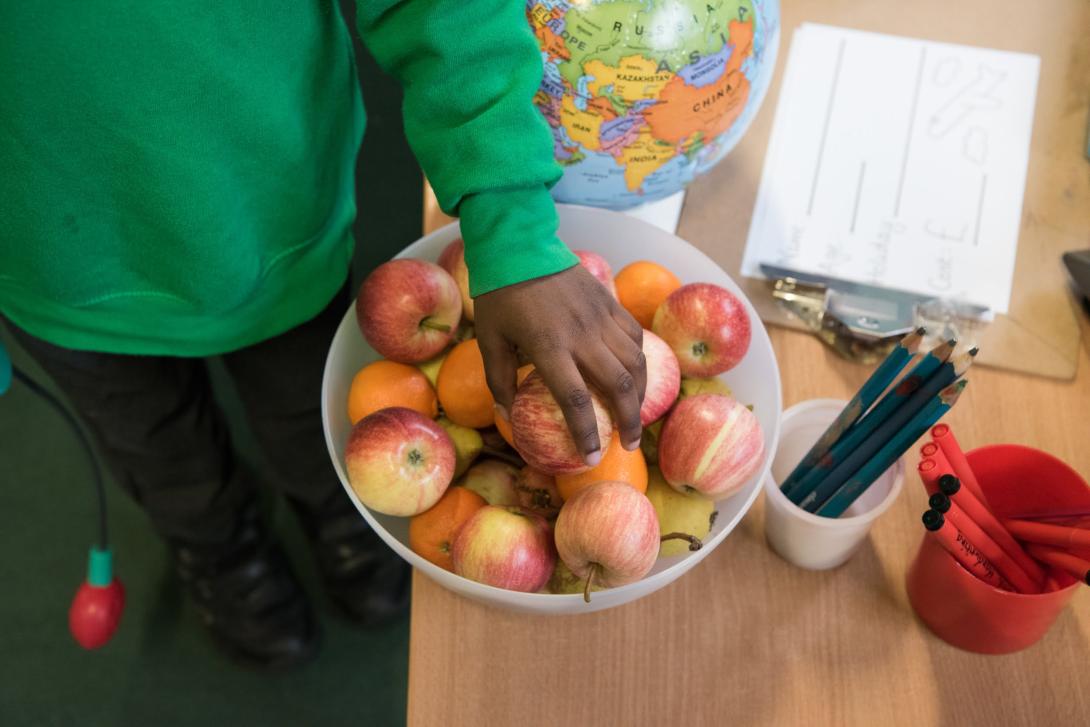25 September 2025
Beyond the Toothache: The Hidden Costs of Dental Decay in Children

Lindsy Vallayil, a NHS Community Dentist in North East London, explores the impact of dental decay and its links to food inequalities and child health. The blog was written in response to a new map showing the UK's stark health and diet inequalities, including the burden of tooth decay across England.
A Silent Epidemic in Children’s Mouths
Dental Caries (tooth decay) is the most common diet-related disease affecting children in the UK(1), but it is also a largely preventable condition. Whilst it is commonly recognised that tooth cavities in children can cause pain and often require treatment, there are other wider effects which can undermine and adversely affect children’s wellbeing, learning and development. Dental caries can create a significant barrier to a child’s educational progress and holistic development, which is why it is crucially important that access to healthy food is improved, and the consumption of ultra-processed sugary food, snacks and drinks in our educational institutions is controlled, and ultimately, significantly reduced.
The Hidden Toll of Tooth Decay
Many children who experience dental caries require a general anaesthetic in hospital for removal of multiple primary (baby) teeth which are so undermined and broken down by decay, that they cannot be filled or restored. In the UK, the leading reason for hospital admission in children aged 5-9 years is dental caries(2). There is a strong correlation with socio-economic status; children from more deprived communities are 3.5 times more likely to require dental extractions due to dental decay than children from more affluent areas(2). The primary dietary risk factor for dental caries is frequent consumption of foods and drinks high in added or ‘free’ sugars, and limited access to healthy, wholefoods; this is exactly the dynamic seen in many deprived communities(3). Other factors that further compound this inequality is the presence of food deserts in low socioeconomic areas, marketing practices which promote ultra-processed foods with high sugar content to low-income communities, and reduced access to dental care providers.
Consequences for Education and Wellbeing
Dental caries and the symptoms it causes can have significant consequences for children’s education and their wellbeing. Toothache and dental infections can lead to missed days from school; many lose at least two school days, with some children missing up to 15 days per year(3). When children with dental caries embark on a course of treatment in surgery (under local anaesthetic, with or without conscious sedation) it is not unusual for them to require three to four appointments to complete all the necessary treatment following their initial examination. This missed time from school, particularly in a child’s early years, can cause significant disruption to their educational progress.
Toothache is often worse in the evening and at night; it is thought that this is related to lying flat which increases blood flow to the mouth and teeth(4), but also because children are likely to be less distracted with other activities. Night-time pain can impact a child’s ability to rest, and poor sleep can lead to difficulties concentrating in school the following day; tired, distracted children will struggle to engage in class.
Pain caused by dental caries can make eating difficult or uncomfortable for children, often leading them to avoid harder or more textured foods such as fresh fruit, vegetables, and protein-rich meals. This limits variety in their diet and can contribute to fussy eating patterns, reduced nutrient intake, and in some cases, undernutrition(5). These nutritional imbalances not only affect a child’s physical development but can also impact concentration, energy levels, and their performance at school.
Beyond the Mouth: Emotional and Social Impact
Dental caries affects far more than just a child’s teeth. Its social and emotional consequences can be significant and long-lasting; poor oral health can profoundly affect how children feel about themselves. Following the 2013 Children's Dental Health survey in the UK, it was found that up to 35% of 12‑year‑olds and 28% of 15‑year‑olds reported feeling embarrassed to smile or laugh because of the appearance of their teeth. Between 45% and 58% of children at these ages experienced at least one negative impact on daily life due to oral conditions, ranging from self-consciousness to social withdrawal and difficulty eating or cleaning their teeth(6). These findings underscore how visible decay, gaps, and bad breath can affect self-confidence and limit social engagement in school and among friends.
For younger children, early tooth loss or severe decay, particularly affecting their front teeth, can also impair speech development, interfering with articulation and communication at a critical stage in learning and social growth.
Impact on the Family
The impact of dental caries also extends into family life. Analysis of the 2013 Children’s Dental Health Survey demonstrated that nearly 30% of parents reported family life disruptions due to their child’s experience of decay(7). Specifically, 15.5% had to take time off work, 14.2% experienced stress, and 10.4% reported feelings of guilt, all directly linked to managing the effects of untreated dental disease in their child(7).
When dental decay progresses to the point of pain or emergency, families can face additional emotional distress, as they witness their child suffering from preventable discomfort and anguish. In their report “Health matters: child dental health”, Public Health England report that 67% of parents have reported that their child had been in pain, and as 41% of children who required hospital admission for treatment of dental caries had parents in employment, this would have resulted in many missed days of work(3). Families may end up seeking private treatment due to delays in accessing NHS dental care, sometimes at significant cost, or they may have to travel considerable distances to access care for their children.
Childhood Decay, Lifelong Consequences
Dental caries in early childhood is more than an immediate health concern; it serves as an early marker of long‑term oral health inequality. A British cohort study demonstrated that children from lower socioeconomic backgrounds who had higher caries experience by age five were significantly more likely to exhibit poor oral health by age 26, including higher rates of tooth loss and gum disease, regardless of changes in social status later in life(8). This emphasises how early disadvantage compounds into adulthood.
Equally concerning is the link between early oral health and dental anxiety in adolescence and adulthood. Children who had invasive dental treatments (or irregular dental attendance) at age eight were more likely to report dental anxiety at age 17 than children who had not had any experience of interventive dental treatment(9). Early preventive strategies to reduce the incidence of dental decay and support good oral health, can reduce the incidence of dental anxiety, and therefore poorer outcomes relating to dental health later in life(9).
The Role of Diet and Food Access
Whilst exposure to fluoride and regularity of oral hygiene measures are important factors when considering the incidence of this preventable disease, the direct link between high sugar intake, especially from processed foods and sugary drinks, and dental caries in children is well established in UK research. Analysis of data from the Children’s Dental Health Survey found that children who frequently consume added sugars, more than four times a day, are significantly less likely to remain free of decay in their permanent teeth compared to those who rarely consume added sugars(10). Those children from lower socioeconomic backgrounds tend to have higher sugar intakes and worse dental outcomes.
Compounding this, access to fresh and nutritious food is highly inequitable. The most deprived fifth of UK households would need to spend approximately 50% of their disposable income (after housing costs) to meet the government’s recommended healthy diet (Eatwell Guide)(11), compared with just about 11% for the wealthiest(12).
Healthy Mouths, Healthy Futures
Dental caries is not just a health issue for children and young people, but it can be a barrier to their education, development and wellbeing. We have a critical role to play in tackling this preventable condition by supporting policies that improve children’s access to healthy diets and early oral health interventions. This includes ensuring universal free school meals meet high nutritional standards, including foods with reduced amounts of added free sugars, expanding fruit and vegetable schemes in schools and early years settings, and championing sugar reduction initiatives alongside engaging education campaigns. A great example of this is VegPower's Eat Them to Defeat Them campaign, which works with schools in the UK to promote an increased consumption of vegetables in children. The campaign’s successes include reports that 77% of parents said their children ate more vegetables, and 89% of schools reported an increase in the vegetable consumption of children(13).
By embedding health through better nutritional choices into education policy, we can shift the focus from treatment of disease to prevention, reducing inequalities and enabling every child to thrive, both in the classroom and beyond.
- To learn more about the burden of tooth decay across England, explore our new map showing the UK's stark health and diet inequalities.
References
(1). Public Health England. Guidance Child oral health: applying All Our Health. 2022
(2). Office for Health Improvement & Disparities. Hospital tooth extractions in 0 to 19 year olds: short statistical commentary 2023. Published February 2024
(3). Public Health England. Health matters: child dental health. 2017
(4). https://www.nhsinform.scot/illnesses-and-conditions/mouth/toothache/
(5). Dental Update. Food Insecurity: An Update on Implications for the Dental Team. Allen, L., Yazdi-Doughty, J. & Albadri, S. September 2024.
(6). British Dental Journal. The impact of oral conditions on children in England, Wales and Northern Ireland 2013. Ravaghi, V. et al. August 2016.
(7). International Journal of Environmental Research and Public Health. Family Impacts of Severe Dental Caries among Children in the United Kingdom. Abed, R., Bernabe, E., & Sabbah, W. December 2019.
(8). Community Dentistry and Oral Epidemiology. Socioeconomic inequalities in oral health in childhood and adulthood in a birth cohort. Thomson, W. M. et al. October 2004.
(9). International Journal for Paediatric Dentistry. Are childhood oral health behaviours and experiences associated with dental anxiety in adolescence? Clow, J. et al. July 2023.
(10). Community Dentistry and Oral Epidemiology. Consumption frequency of added sugars and UK children's dental caries. Hong, J. et al. October 2018.
(11). The Eatwell Guide - GOV.UK
(12). The Food Foundation. The Broken Plate 2023: The State of the Nation’s Food System. Goudie, S. June 2023.
(13). VegPower: “Eat Them to Defeat Them” Campaign. Home - Eat Them To Defeat Them 2019





